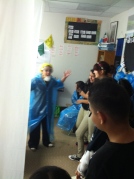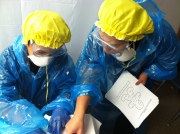Our organization’s teacher mentoring/induction program spans six different schools, and it’s always a challenge to set a meeting time that works for everyone. In an answer to that dilemma, we conducted our first Virtual Learning Community this month, and I am really excited about the potential of this solution to impact mentoring and teaching practice in the future.
The idea for a Virtual Learning Community arose due to scheduling difficulties, but there are other benefits, too. Keeping the VLC online in a learning management system also archives the discussions and content, and makes it accessible for future use. This was one of the areas that our mentors appreciated the most as a result of putting the learning community online.
In designing the VLC, it was important to me that we adhere to the foundational principles behind a face-to-face professional learning community, and that the VLC provide an arena for meaningful dialogue and collaboration, not just dissemination of information. I know that I can simply create a screencast if my objective is to deliver content. However, using a learning management system enables me to create, monitor, and participate in discussion boards, which was a valuable component to our VLC. The mentors (participants) really appreciated the ability to work asynchronously on their own schedules, too.
Our VLC was housed within the Haiku LMS, which enabled me to create a quick, 5-question pre-assessment for mentors to give me an idea of their understanding and comfort level around our upcoming formative assessment piece, the Fall Mini Inquiry. I used this data to inform the content of the discussion boards and screencast. The opening discussion board was an online version of a New Teacher Center protocol, “Problem Pose/Problem Solve”. Mentors were responsible for sharing a dilemma of practice on the Board, and then responding to two other posts. I provided them with a rubric ahead of time so that there were clear expectations around the level of depth and reflection I was looking for in these posts. I was pleased to find meaningful exchanges between mentors at totally different sites and with different content area specialties in this Board.
Next, the mentors had to watch a screencast that I created in response to the pre-assessment data. It was about 13 minutes long. In the future, I would like to cut this down to under 10 minutes, and actually embed a VoiceThread within Haiku so that I can ask Mentors for asynchronous collaboration right on the uploaded media. This time around, I had created a “post-assessment”- containing the same 5 questions in the pre-assessment-which showed that all of the mentors improved in their understanding and comfort level around the Mini-Inquiry process as a result of the screencast.
Finally, I created a “content-based” discussion board, which asked mentors to respond to a question that stemmed from the screencast. Again, they were asked to create an original post, and respond to two other colleagues. The question asked mentors to reflect on the specific mentoring/coaching language they intend to use with their participating teachers during the Mini-Inquiry process. Asking them to provide specific examples and rationales ensured that they were reflecting on previous professional development we received through the New Teacher Center, and preparing a practical application to their upcoming work.
Overall, I think the Virtual Learning Community was a success, although I intend to refine it and add some new elements for our next round in February. I am interested in working with some of our site administrators to explore ways in which this concept might be applied to the existing Principal’s PLC, or even to accent the traditional PLC work done by teachers at each site. This could be a great way to help articulate between our schools (we have Pre-K through 12th Grades) to ensure continuity and share best practices in the departmentalized subject areas.
Signing off, I also have to acknowledge the efforts and flexibility of our team of Mentors, most of whom are first year Mentors and full time classroom teachers. I truly appreciate their willingness to not only participate in this new learning community, but also to make it meaningful and relevant to their practice as mentors.
 Screencasting seemed like a good option for this, but Explain Everything takes it to another level. I was able to use Dropbox to import files and photos to create a storyboard, and then narrate through the slides. A cool feature of EE is that you can adjust the slides as you are recording, capturing any movement, drawings, etc. as you go. It was a user-friendly experience for the most part; I watched a ‘how to’ YouTube video and I was up and running in no time. Here is a link to my first video, Curriculum Mapping for our school’s Social Studies/Science teachers in light of the new CCSS content-area literacy standards. When delivering the curriculum mapping PD to the whole staff, we were able to get the content area teachers to work without forcing everyone to listen to the technical updates that didn’t apply to them. I am so excited for future PD using this app! Such a great example of technology that can provide solutions and enhance our work as educators.
Screencasting seemed like a good option for this, but Explain Everything takes it to another level. I was able to use Dropbox to import files and photos to create a storyboard, and then narrate through the slides. A cool feature of EE is that you can adjust the slides as you are recording, capturing any movement, drawings, etc. as you go. It was a user-friendly experience for the most part; I watched a ‘how to’ YouTube video and I was up and running in no time. Here is a link to my first video, Curriculum Mapping for our school’s Social Studies/Science teachers in light of the new CCSS content-area literacy standards. When delivering the curriculum mapping PD to the whole staff, we were able to get the content area teachers to work without forcing everyone to listen to the technical updates that didn’t apply to them. I am so excited for future PD using this app! Such a great example of technology that can provide solutions and enhance our work as educators.







